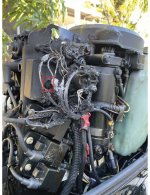@Texasmark
The second red wire (un-fused) that also connects to the same 12V battery point (or further down steam) as the other red (fused?) output power wire, is called the sense wire (local or remote).
As designed intentionally, sensing is done with at high input impedance level. As the sense wire enters the rec/reg unit it is wired/protected through a 10K/100K resistor for example.......Therefor, if the rec/reg module has a catastrophic failure and if any active or passive circuity internal to the module shorts to ground (as in our case here did) AND if the failure becomes internally in contact with or even near the sense wire, by nature/design, it is current limited.
12V/10K = 1.2 mA........Hence no fuse required, it's "intrinsically safe" by design.
As where in the case of the (fused?) output wire, by nature/design it CAN'T be a high impedance (outputs are by nature low impedance), if a failure occurred internally to or near ground on this wire...........
12V/0.01ohms = 1200A......Hence fuse required and as seen on the newer merc rec/reg's, BUT only required on this wire.
This (above) relates only to failures in the rec/reg..........which is what we ASSUME happened.
HOWEVER.......
Any and all wires connected directly to a battery source (which both the rec/reg's output and sense are) that run over some xx distance (ABYC reg here) MUST also be fused in the event the wire ITSELF leading from this battery connection shorts at or near ground.
If ran in "remote" mode.............Mine runs like 5' away to my pro-mariner, so it's fused with a 1 amp fuse.
In local mode, the sense wire only needs a run like maybe 6" so no fused is required according to the ABYC reg if memory serves.




















